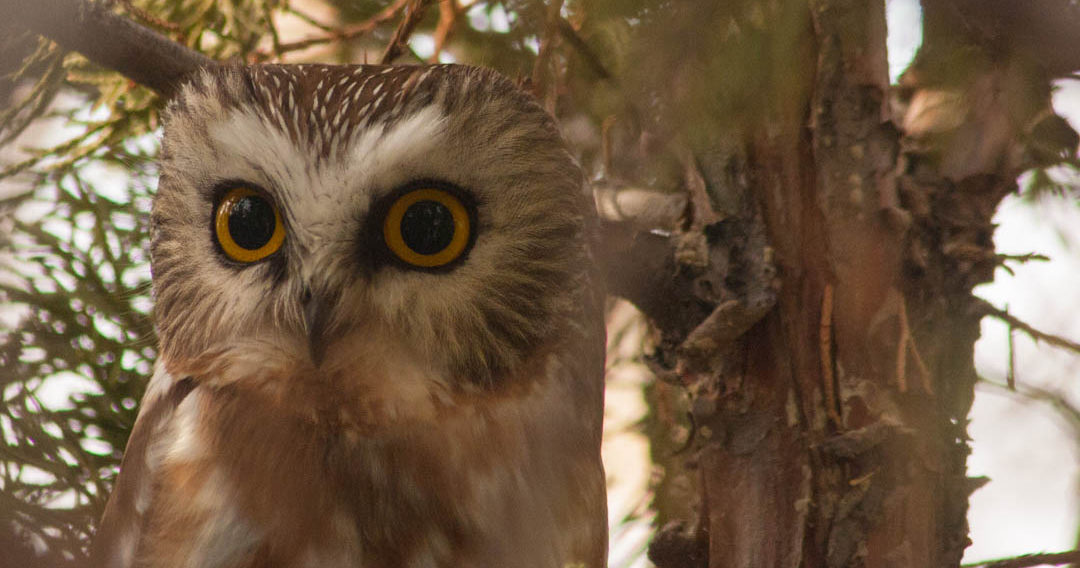Intense, grating, bird alarms erupt in the thicket along-side the creek. I hold the dogs at my side and ask George, “do you hear that?” “Yeah,” he replies in a knowing voice—”there’s something in there”. “Yeah,” I say, “you should go look and see what it is.” This is so often how it happens—an easy morning walk with the dogs derailed completely before we even reach the end of the driveway. The magic of our surroundings is always allowed to interrupt our days.
There are easily ten to fifteen small birds screaming bloody murder: black-capped chickadees and mountain chickadees and Townsend solitaires all chime in. Each bird is intently focused on one particular juniper. We walk this route daily and so, when an of alarm of this sort takes place—It is like a neon sign has been flipped on—today it reads DANGER. Count the “dees,” I tell George. What “dees,” you might ask? It’s the chick-a-dee’s “dees”—the more dangerous the perceived disturbance, the greater the number of “dee’s” attached to the bird’s call. For a person sitting quietly, only 2 to three “dee’s” may be heard, whereas a person walking at a normal pace with a dog, the count might be 4 to 8 “dee’s” in a row. If in the presence of a predator that specifically targets small birds, it’s a different story altogether. When in the company of a Cooper’s hawk or pygmy owl, one might hear as many as 15 to 18 dee’s in a row.
What we hear this morning is not quite as high on the “dee” tally as a sharp-shinned hawk, but it is not far off. Research By Erick Greene at the University of Montana has shown some amazingly detailed vocalizations coming from chickadees and other birds in the Rocky Mountain West. In the case of our common black-capped chickadees, they have specific alarm calls that go beyond announcing a basic category of threat such as “owl” or “hawk” but delineate exactly what species of owl or hawk. Not only are these calls heeded by other chickadees, but the entire bird and mammal community: white-breasted nuthatches, chipmunks, red-breasted nuthatches, brown creepers, ruby-crowned and golden-crowned kinglets, red squirrels, Townsend’s solitaires and more. This cross-species information highway is akin to the universal sign language used by native American cultures; though each group had its own linguistic traditions, a cross-cultural system of speaking through hand gestures was universal.
In less than a minute we spot it! George calls out to me, “a predator, a predator bird!” And he is right. Tucked deep in recesses of the juniper is a dark shape hiding in the shadows. The subject of all these alarms is nearly invisible and would have gone completely unnoticed had it not been for the bird chatter. Several more minutes are needed to find a clear view. “Ahhhhh, Come here! Look! Look!” I fit my hands under George’s arms and lift him up. “Oh,” he says,”Look at those eyes! Dad! It has a mouse too!” Through a small tunnel in the juniper bows we see the statuesque saw-whet owl. The earthy brown streaks on its chest, head and wings could easily have been taken for tree bark or sun-dappled vegetation, but those piercing gold eyes gave it away. The dead rodent clutched in its talons left no mistaking, this little fluff-ball, was a fearsome predator! Think of these bird conversations the next time you’re out in your own backyard. The sounds coming from your local bird community are not simply ‘noise’ or decorative tunes meant to beautify our soundscape, rather, they are finely-tuned bits of data on a vast network of shared intelligence, one that is been fine-tuned for thousands, if not millions of years. Tune in. Your feathered neighbors maybe saying a lot more than you ever thought possible…. life and death could just be a few “dees, dee, dee, dees” away!

